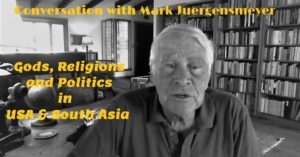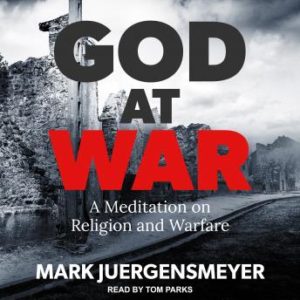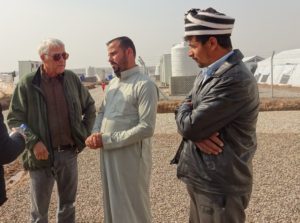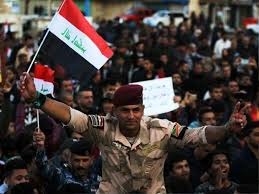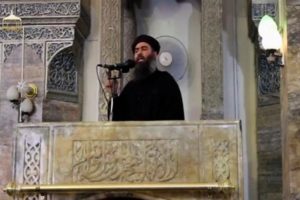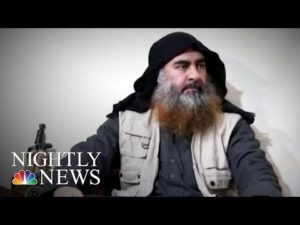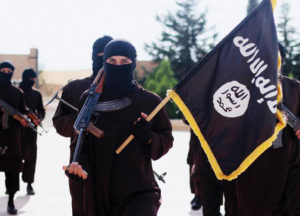This interview with Mona Sheikh, co-editor of Religion, Conflict and Global Society, a festschrift honoring me, was posted on the website of the Danish Institute of International Studies on November 13, 2020
Tribute to a pioneer of the academic fields of religious violence and Global Studies: Mark Juergensmeyer turns 80
When the book The New Cold War? Religious Nationalism Confronts the Secular State came out in 1993, its topic seemed slightly peripheral to the public debate as that was looking at the time.
After the end of the Cold War, religion didn’t excactly seem like a very important fault line in international politics, and the book’s author, Mark Juergensmeyer, a scholar especially of Gandhi’s thought and Sikh extremism, among other subjects, wasn’t a traditional expert on either the Middle East or terrorism.
These two subjects did gain some attention, when in the same year a group of Islamists tried to blow up the World Trade Center, failing to do so, but in the process still killing seven people and alerting the world to the rise of Islamist terrorism.
The book acquired quite a lot of academic traction, and when seven years later Juergensmeyer published another book on the confrontation between religious extremism and the modern state, Terror in the Mind of God, the book seemed almost prophetic in explaining an event that would come to define the coming years.
All major religions have potential for violence
A few months later, two airplanes crashed into the World Trade Center and turned Juergensmeyer’s subject into the topic that overshadowed practically everything else on the planet.
“His ambition was to show that all major religions of the world has the potential for violence, that they are upheld by mythological imaginations, and that they are very much alike in that sense,” explains Mona Sheikh, head of the Global Security and World Views unit at DIIS.
“And then 9/11 happened, and he had a chapter on al-Qaeda. At the time not many people knew anything about al-Qaeda, and not much had been published. For that book he had actually interviewed one of the perpetrators behind the attack on the World Trade Center in 1993,” she adds.
”Already back then he wrote about the conflict lines in a new Cold War. Now it was religious nationalism versus secular nationalism. In a way, it became quite prophetic compared to populist currents that arose in many countries, and the way religion increasingly became a visible force in politics,” continues Sheikh, a former Ph D student of Juergensmeyer’s at the University of California, Santa Barbara, and today the leader of the ERC-funded project on Transnational Jihad and Containment and one of the instigators of a Festschrift celebrating Juergensmeyer’s 80th birthday today, to be published at the beginning of 2021.
About Mark Juergensmeyer:
Juergensmeyer is distinguished professor of sociology and global studies, and affiliate professor of religious studies, at the University of California, Santa Barbara, where he was the founding director of global studies and the Orfalea Center for Global and International Studies. He is a pioneer in the global studies field, focusing on global religion, religious violence, conflict resolution and South Asian religion and politics. He has published more than three hundred articles and twenty books, including the revised and expanded fourth edition of the award-winning Terror in the Mind of God (University of California Press, 2017)
“Right after the Cold War, there was this widespread notion that a secular model of society could also solve the problems of Muslim countries. There was great opposition to that mindset in parts of the Muslim world. Movements such as the Taliban – which have been a large part of my research – were strongly opposed to that notion, and other Islamist movements as well. In his writings, Mark challenged this standard thinking, that secularism was the victorious idea. He was also critical of the universalist way of thinking about secularism.”
Large influence
9/11 would have terrorism and security-experts jumping out of practically every cupboard to explain the new threat to Western civilisation, focusing in a narrow way on security, networks or and the interpretation of religious doctrines.
Although an inspiration to many, and with an obligatory presence on the curriculum of the field of religious violence, Juergensmeyer would take a different path. This consisted in not focusing narrowly on Islam when analysing religiously motivated violence, but looking, for instance, at the Christian sectarians of Waco in much the same way and drawing on many different fields of research when researching instigators of religious violence.
“His perspective has always been comparative, showing that there are some of the same mechanisms that apply in different forms of religious violence. There is, of course, something particular in each tradition that we must understand, but often there are some similar mechanisms that mobilize people. In a way he represents a very unique blend of focusing on texts and myths as theologians often do, but at the same time insisting on meeting and talking to the people that his research centers on, as anthropologists often do. And then he invented the concept of ‘cosmic war’. This is the concept of a struggle between good and evil, and how earthly conflicts are often elevated to this ‘sacred drama’, as he calls it. Most world religions have a concept of good and evil, and many of the world’s conflicts are seen through that prism, including by the secular parties that might be involved. He talks about the religious mobilization of violence, but has also made significant contributions to peace and conflict research,” she explains and continues:
I had heard so much from him about the importance of being in the field and talking to those you are actually studying and trying to explain. There is also a tendency in some scholarship to look first and foremost at the doctrines of these religions and conclude solely from them, without taking into account that it is people who read these texts and interpret them
“His contribution is in explaining why most of the world’s religions have also spawned militant movements. What he is looking at are these mythological tales in the religious traditions. Not because he explains it causally – that because there are those notions, then they are violent per se – but he explains that there is a potential for violence in the religious imageries”.
Not just one explanation
– I guess it must also mean something having a different background from many other modern researchers of religious violence; having studying Gandhi, Sikhism etc. before arriving in the world of jihadist terrorism?
“”Yes, he also trained as a theologian and a political scientist, and worked as professor in the sociology of religion. He has always worked in a very multidisciplinary way, which defines his approach, but his method is basically very anthropological, exactly because he has been out interviewing many of these religious and militant leaders”.
– What does the multidisciplinary approach mean when working in these fields?
“It means that you do not find the explanation in one place, but that it is a combination. We humans are not just characterized or driven by one meta-identity; we are many things at once – we are political beings, we are also religious beings, we are family people, and one has to take this into account. There is a tendency in terrorism research to look for a singular explanation‚” she explains.
If one concludes that these people are not just out of reach, then it opens up a space for dialogue, reconciliation, compromises – to speak to each other. Much of the counterterrorism discourse after 9/11 has insisted that you cannot talk to these people
“Political scientists are looking for political explanations for why people act the way they do; with religious scholars it is, of course, about faith, and anthropologists have gone out and tried to understand people’s life worlds. He has always combined these methods and factors. He also analyzes religious texts – what kinds of conceptions and imagery they facilitate. Complemented by many, many hours of interviews with militant actors, which have given him a high degree of credibility. I have personally been very inspired by this and have taken that approach with me in my work interviewing the Taliban, because I had heard so much from him about the importance of being in the field and talking to those you are actually studying and trying to explain. There is also a tendency in some scholarship to look first and foremost at the doctrines of these religions and conclude solely from them, without taking into account that it is people who read these texts and interpret them, and that these interpretations can change over time according to context‚” Sheikh explains.
Creating a new field of research
Juergensmeyer is also a partner in the Explaining Transnational Jihad project at DIIS, is involved in a large project at Uppsala University and is Honorary Professor at Roskilde University Centre. At the latter, his work in establishing a whole new discipline of research, Global Studies, has led to the creation of a department specialising in the effects of globalisation from a multidisciplinary and transnational perspective, seeking to understand the dynamics from many different cultural standpoints.
About the Festschrift:
The book “Religion, Conflict and Global Society – A Festschrift celebrating Mark Juergensmeyer” (Edited by Mona Kanwal Sheikh and Isak Svensson) will be published in 2021 with contribution from scholars from different disciplines: Giles Gunn, Gurinder Singh Mann, Helmut Anheier, Isak Svensson, Manoranjan Mohanty, Margo Kitts, Mia Bloom, Michael K Jerryson, Mona Kanwal Sheikh, Monica Toft, Reza Azlan, Rich Appelbaum, and Ron E. Hassner.
Mona Sheikh talks affectionately about an icon who, both personally and professionally, has clearly meant quite a lot to her – and she also readily admits to being influenced a lot by his approach.
“We have looked a lot at his way of working. After all, our approach is also very much about understanding jihadism from an insider perspective; what kind of world view is being projected? What are the kinds of religious beliefs characterizing transnational jihadism that make them stand out against previous generations’ jihadism or Islamism? What I have tried to develop in collaboration with Mark is a method of understanding the link between the sociological and the theological,” she says.
“When I was in the United States, we started working on what we called a sociotheological approach to the study of religious violence, which combines a focus on people’s world views with a focus on their social vocation. One must understand how people interpret the religious notions in the concrete circumstances in which they find themselves.”
The idea of good and evil
– In the Introduction to ’Terror in the Mind of God’, he mentions feeling a certain kinship with these strongly religious militants in their social activism and desire to create change through religion – without, of course, endorsing the violence. Does that differentiate him from other researchers, that he doesn’t necessarily start out from a point of condemnation?
“That is an important point and reflects his method of emphatetic immersion into the worldviews of those he his studying. Both within and beyond academia, there is often a demonization of these movements, especially when it comes to militant movements that draw on religious imaginaries to justify acts of violence. His point is that these people can also be driven by the idea of the good and the righteous – they also want a just society, but people disagree about what the just society is. The Taliban are characterized by the ambition to create order and justice – but they connect it with a vision of the divine, while in our part of the world we often connect justice and law and order and equality before the law with secularism. It is an important point that these people are not necessarily evil per se. If you open yourself up to a more nuanced portrayal, it also means that you can talk to these people. And that’s where his research is heading these days, more towards peace research and conflict resolution,” she adds.
Terrorism research is still very focused on individual explanatory models, where one follows the individual’s radicalization and network, which people they have been influenced by, a microsociological approach in one sense or another, very focused on individual processes
“If one concludes that these people are not just out of reach, then it opens up a space for dialogue, reconciliation, compromises – to speak to each other. Much of the counterterrorism discourse after 9/11 has insisted that you cannot talk to these people, they are driven by evil and hatred towards the West. That narrative is altered if you put a face on these people and tell their story in terms of their own premises and thus provide access to their world view”.
– A more holistic approach to religious violence, and also putting Christian fundamentalists in the same box as jihadists, I guess, would also be a tad provocative to many people?
“Yes, and it only became that way after 2001. Until then, terrorist research was not about jihadism and Islam in the same way at all. There was a more equitable distribution, and much of the research was about secular militant ideological movements or Christian evangelists in the United States. But Mark has also been in the field for so long that he can demonstrate that there is no natural connection between any one single denomination and its violent expression, but that it occurs in many different variants”.
– Is there more room for that way of understanding terror and jihadist movements today than there was ten or fifteen years ago?
“Probably among parts of academia there is a countertrend that wants to challenge simple causality models, or the essentialism in the study of religion. But it requires more multidisciplinary work. Terrorism research is still very focused on individual explanatory models, where one follows the individual’s radicalization and network, which people they have been influenced by, a microsociological approach in one sense or another, very focused on individual processes. What Mark also contributes is to lift the gaze a little from that and look at some ideational structures and how they relate to the feeling of being misrepresented in the world. And that this is also a universal mechanism,” she replies.
“In a way, it is becoming more common, because we are also seeing a globalization in academic fields. We do not think as sectarians as we did before 9/11 in the field of terrorism. Disciplinary borders do not mean that much anymore. And I think to a large extent that this development is part of Mark’s legacy over the years.”

